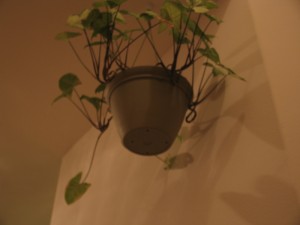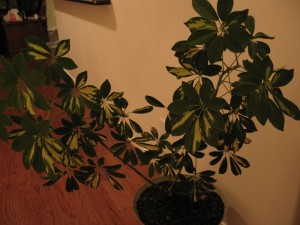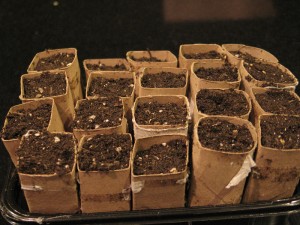Posted by Aimee | Posted in Guides | Posted on 20-05-2009
Tags: drainage hole, drainage holes, guide, house plants, Planting, vining plant
Now is still an okay time for transplanting houseplants. Though technically you can transplant at any time the general belief is that it is very best to do so before a growth period. Here in the last week I transplanted two house plants and I will be transplanting the African violet tomorrow night. A bit later than I wanted to but other things just took priority. Two of the plants I have not yet identified, they came with the house as housewarming presents.
To start with you will want to cover your work area with newspaper if it is available, this makes clean-up much easier. Also you definitely want to do this somewhere that there is not carpet, it is much easier to sweep up any spilt soil than trying to vacuum it up. You may want to gather a couple of tools together at this point: the pot into which you plan to place your plant(this should have a drainage hole and something like a saucer to catch excess water), the plant being transplanted, decent quality potting soil, gloves, and a water source.
Now that you have everything gathered together let’s put on our gloves and get to work. First lay down a layer of soil into the pot, some people like to put a layer of rocks or marbles to prevent soil from escaping out of the drainage holes, recently though I read that this does more harm than good, which way is better I do not know. Then over the pot you are transplanting into tip the contained plant upside down supporting the stem with your hand spread out and inspect the root ball. If it looks very tightly bound now is a good time to gently work the roots outward with your fingers being careful not to tear any of the roots. Now set your plant level into your new pot. Make sure the pot is not too big or small for its new occupant, one assuring the proper size and that it is level by adjusting the soil below the plant to make it so, fill in around the sides with your potting soil gently, if you want you can add in a small amount of granulated slow-release organic fertilizer such as MicroLife. When the soil is about an inch or less from the top of the pot, gently firm the soil down around the plant making sure not to place any pressure on the stem. If there seems to be too much room around the top add some more soil or you can add a layer of decorative stones over the dirt, this can help deter house pets from digging in the soil. Now water your plant deeply and do not water again until the soil feel dry even when you stick your finger an inch deep into the soil.
There you go, that’s all there is to it. I am sure your houseplant will be quite happy in its new home. Don’t forget to rotate your pot about a quarter inch weekly to keep light distribution even and dust the leaves on occasion with a damp paper towel to remove any dust or mite build-up. Also it is good to remember that it is better to water plants less often and deeply to help prevent salt build-up. In general house plants do not require a great amount of care and they are beautiful as well as purify the air in our houses which often times contains even more pollutants than the air outside.





